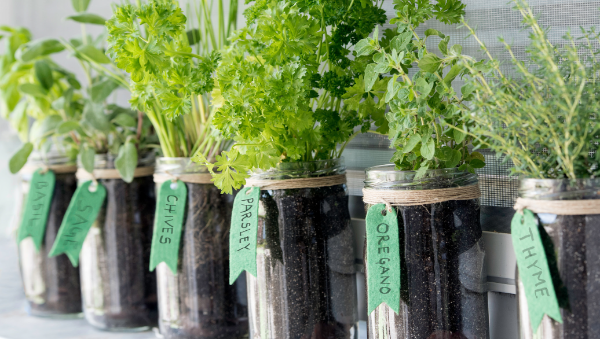Pots of Possibility: Herbs that Thrive Indoors
There is something satisfying about using fresh herbs in the middle of winter when the landscape is brown and bare. To be able to pick the herbs from your own plants is even more gratifying. As our Montana growing season is ending, consider starting a winter herb garden inside to enjoy fresh herbs year-round. Although it is slightly more challenging than growing them outdoors, many herbs can successfully be grown indoors.
For the purpose of this article, herbs are defined as plant parts, often leaves, that are used to flavor or season food. In addition to being a food source, indoor herbs also provide fragrant foliage and visual interest. Like other houseplants, they can absorb carbon dioxide, increase oxygen levels, increase positive feelings, reduce sound levels, and reduce stress levels.
SELECTING THE RIGHT HERBS
Some herbs grow well in containers while others struggle. Easy-to-grow herbs include parsley, mint, chives, basil, oregano, cilantro and thyme. Other options that are a little harder to grow indoors are rosemary, sage, lemon balm and marjoram. Avoid herbs with large root systems like horseradish and fennel. If you have indoor cats and dogs, consider avoiding toxic plants such tarragon.
Perennial herbs that were grown outside during the summer can be brought in for the winter. Examples are rosemary, chives, thyme and mint. Some herbs, such as mint and chives, benefit from a light frost before they are moved indoors, which will induce a rest period and stimulate growth. Annual or biennial herbs such as basil, parsley, cilantro and caraway can be successfully started from seed indoors.
CREATING THE RIGHT ENVIRONMENT
It’s important to choose the right container with well-drained potting soil and a pot that has sufficient drainage holes in the bottom. Clay or terracotta containers work well for herbs because they are porous, which allows the soil to dry more easily between watering. However, there are a variety of other container options too. Grouping plants with similar growing requirements together can be helpful for creating a favorable microclimate and can also simplify care practices such as watering.
Most home temperatures are perfect for herbs. Lighting is a much bigger issue. Many herbs are Mediterranean plants, so they need a significant amount of sunlight. At minimum, they need a window space that will allow them to receive at least six hours of direct sunlight each day. However, some species such as rosemary, thyme and bay laurel (bay leaves) need 12 to 16 hours a day and it will be necessary to supplement light with a full-spectrum LED or florescent grow light. If plants are long and lanky, that is often a sign that they are not getting enough light.
CARE
Watering depends on the species, but in general water when the soil is dry to the touch. Overwatering is the most common issue with houseplants, and can lead to increased disease issues, most commonly root rot. Generally, herbs don’t need much fertilizer but could benefit from diluted fertilizer, used sparingly as needed throughout the winter.
Lack of humidity can be a concern in our arid environment but is generally not a major problem for herbs. Wood stove use may cause more of an issue. If humidity is an issue, then grouping plants together, spraying or misting the leaves with a water bottle on a regular basis, or placing a humidifier nearby can help.
HARVESTING
Harvest the same as outdoor herbs. Most herbs can handle periodic snipping and often have the best flavor right before flowering. Some leafy herbs like basil, chervil (a type of parsley) and parsley can even be cut back significantly. For herbs in the mint family, such as basil, cut on the stem right above a set of leaves. This will promote growth and result in a bushier plant. For perennial herbs such as chives, oregano and thyme, only remove one-third of the top growth if you plan to move them outdoors for the summer.
Perennial plants can be moved outdoors when the threat of frost has passed. Slowly acclimate them back to the outdoors to more intense light and wind. Start by placing the pots in a protected outdoor location with partial shade for a few hours a day. Gradually increase the duration outside and the amount of sunlight until they are fully acclimated. This process generally takes about two weeks until the plants are ready to be outdoors full-time.
Once annual plants have flowered, they are usually coming to the end of their life. The flavor may change, and is often less favorable. If you have a significant harvest, drying herbs is a good way to preserve them. Air drying is the best option as it results in the best flavor. Hang four to five stems together upside down with a clean string in a dark, warm, dry, well-ventilated room. It typically takes 7-14 days to dry most herbs completely. Other methods for drying herbs include the microwave or oven, but this takes specific techniques to avoid overcooking and to preserve the flavor. Once dry, store in an airtight container. Stored correctly, herbs can be used up to a year.
For more information about herbs, refer to the MontGuide Herbs for Montana Gardens (MT200003AG).
Allison Kosto is the MSU Extension Agent in Broadwater County.

